by Mark Nemtsas | Jul 3, 2015 | News, Tips and Tricks
On July 1, 2015 the “Healthy Work Places, Healthy Families Act of 2014” came into force in California. One of the provisions under this act was the entitlement to mandatory paid sick days for about 6 million workers in California. In it’s simplest terms, employees can accrue 1 hour of sick leave per 30 hours worked, given that they work at least 30 days in the year and subject to a 90 day probation period. Employers are entitled to cap the accrual amount to a maximum of 3 days (24 hours) per year but can allow for more, and in fact, the accrual scheme allows employees to accrue more than the 3 days per year. The act also allows employees to carry sick leave into the next year but allows for a cap of 6 days or 48 hours, basically two years worth of sick days.
There’s a very detailed Q&A information page on the California Department of Industrial Relations Website here. It covers issues such as which employees are eligible, how many days of work are required for eligibility, and employer reporting requirements. Regarding those it says:
Employers must show, on your pay stub or a document issued the same day as your paycheck, how many days of sick leave you have available. Employers also must keep records showing how many hours you earned and used for three years. This information may be stored on documents available to employees electronically.
Time Clock MTS can be used to automatically accrue, track, and report on these new paid sick days. The exact method you’d use would vary based on how employers decide to implement paid sick days, but in it’s simplest form a sick leave accrual scheme would:
- Have a 90 day eligibility period.
- Have an accrual start date of 7/1/2015 for an existing employee.
- Cap annual accruals at 3 days.
- Carry hours forward on yearly rollover.
- Cap total accrual amount to 6 days.
A sick leave accrual scheme in Time Clock MTS that complies with each of these rules could be setup easily and would look like the screenshot below:
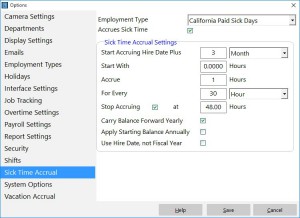
California Paid Sick Days Accrual Scheme
You’d also need to assign the employees to the correct accrual scheme and set their accrual start date to 7/1/2015. You can do that via each employee’s Payroll Information screen (see image below).
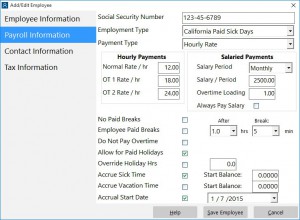
Payroll Information – Set Accrual Start Date
If you’re not sure what accrual schemes are in Time Clock MTS and how you’d use it to record sick days then you should read read this article on sick time accruals and this article on using Time Clock MTS to record sick time taken.
To comply with the reporting requirements you’re going to need to setup the “Accrual Information” report section template on the report settings screen. You’ll need to make sure you include the data fields <SICK_TIME_TAKEN_PERIOD> and <SICK_TIME_TAKEN_PERIOD> in the section template somewhere. Something like this would work:
Sick Days:
Sick Time Taken: <T><SICK_TIME_TAKEN_PERIOD> hrs (report period)
Sick Time Owing: <T><SICK_TIME_OWING> hrs
You can make this information available to employees directly from within Time Clock MTS by allowing them to view their own time cards.
by Mark Nemtsas | Jun 29, 2015 | How To
This Time Clock MTS how-to guide is for users of the software who are replacing their in-house file server with a new one and need to move their time clock data file from the old server to the new one. This guide covers what to do with both the Time Clock MTS Administrator software and the Time Clock MTS Client software.
Moving the Data File
1. Set Up New Mapped Drive
The first step in the process is to set up a mapped drive on your new server that points to the folder that your time clock data file is going to reside in. All computers that have Time Clock MTS on them must have full read/write/delete permissions on this folder. The actual process of setting up a mapped drive (and assigning correct permissions) is beyond the scope of this article but this guide may be useful. For this tutorial we’ve set up folders in the Windows Explorer window below. In the bottom left you can see mapped drives to the Old Server and the New Server, which are the G:\New_Server and H:\Old_Server folders. Of course your folder names and paths will be different but for the sake of an example we’ll work with this for this tutorial.
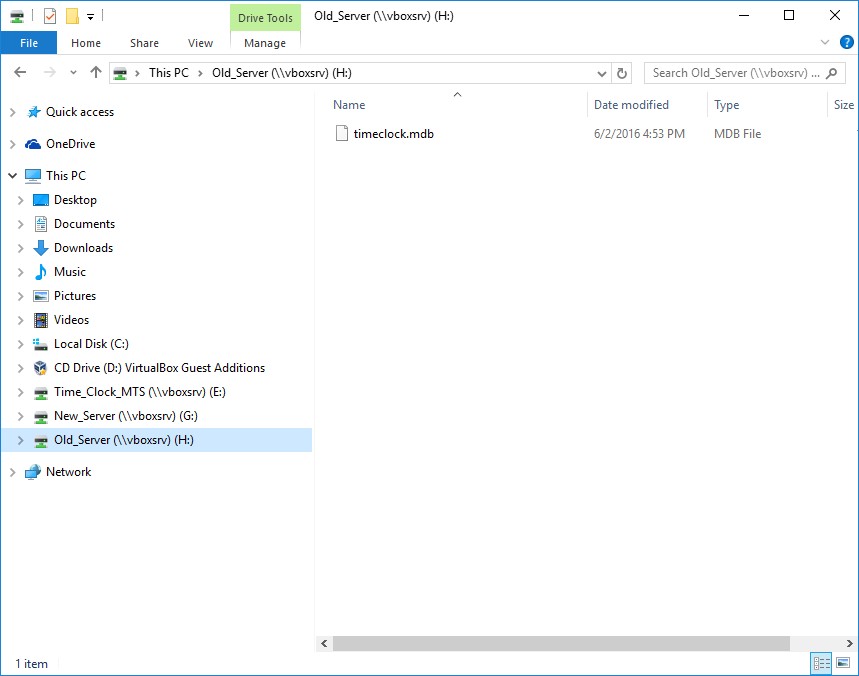
Setting up the Mapped Drives
2. Move the Time Clock MTS Data File
Whether you’re using the Stand Alone Edition or the Network Edition of Time Clock MTS the first step is to move the Time Clock Data File to your new mapped drive. This is done by starting up the Time Clock MTS administrator software and logging in as the administrator using the File->Log in as Administrator menu and going to the Tools->Options->System Options screen. You can see that screen below.
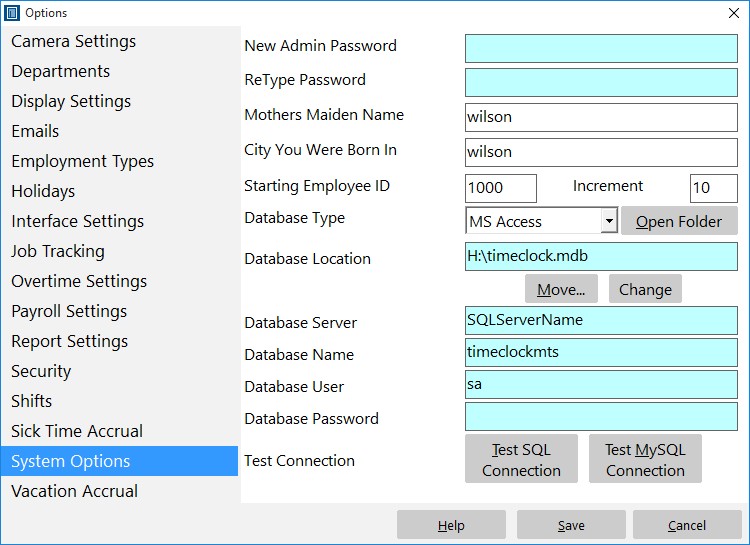
The Time Clock MTS Administrator System Options Screen
Once you’re on that screen click the Move button. You’ll then be asked to confirm that you want to move the data file via these two screens:
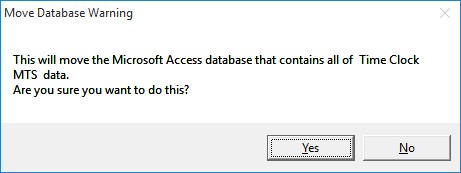
Confirm the Move
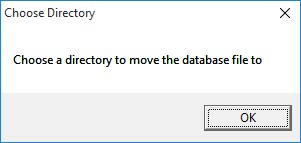
Now Select a Directory to Move it To
Once accepted you’ll be shown a Windows Explorer window like the one below. It will be opened by default to the directory that your time clock data file is currently in (on your old server). In this example that’s the H:\Old_server folder.
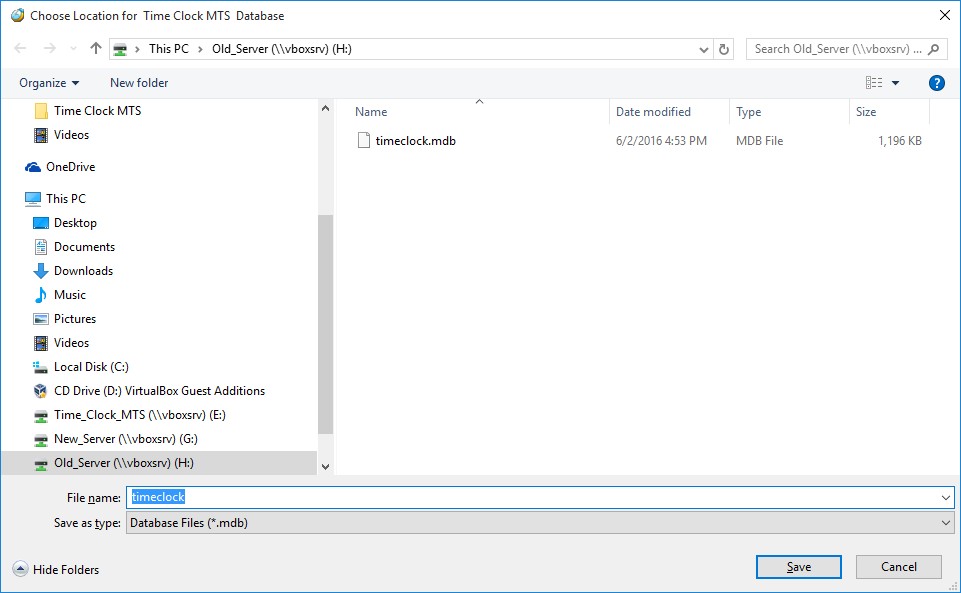
Moving the Data File Location 1
Just navigate to the new folder where your data file is going to be moved to (on your new server). In the case of our example that’s the E:\New_Server folder.
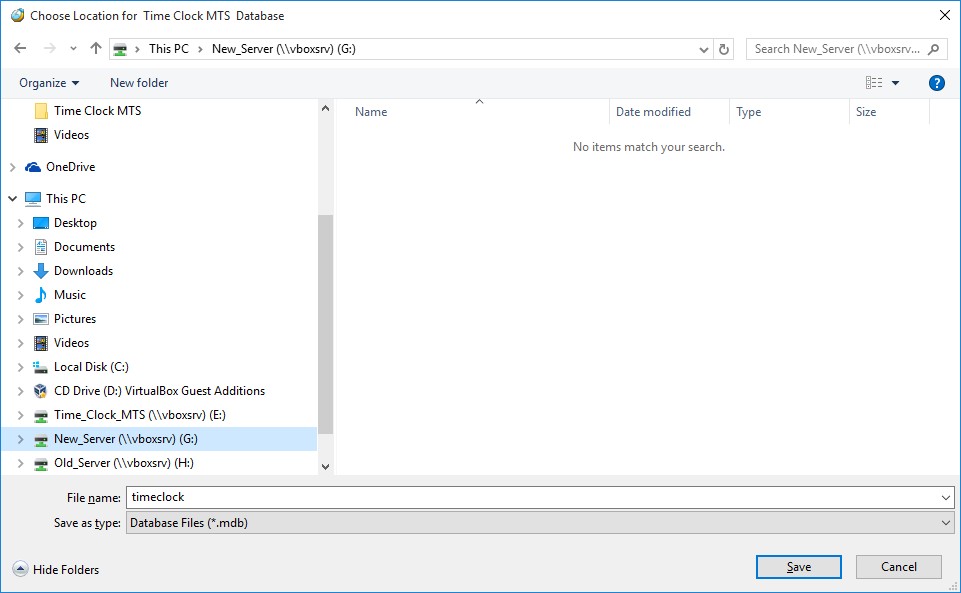
Moving the Data File Location 2
Once you’re done selecting the folder to move your data file to click the Save button and you’ll be shown the screen below informing you of the success of the move. If you’re using the Time Clock MTS Stand-Alone Edition then that’s all that you need to do to move your data file to your new server. If you’re using the Time Clock MTS Network Edition then please read the Redirect the Time Clock MTS Client Software section of this how-to article.
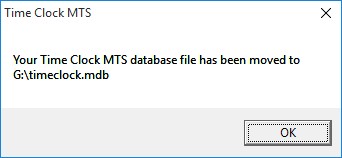
Success! The file has been moved.
Redirect the Time Clock MTS Client Software
Once you’ve moved your time clock data file to your new server you’re going to have to redirect the Time Clock MTS Client software to look for the data file in the new location. Note that you’ll have to do this on every computer that has the client software installed on it. Start up the Time Clock MTS Client software and log in as the administrator using the File->Log in as Administrator menu and go to the Tools->Options->System Options screen.
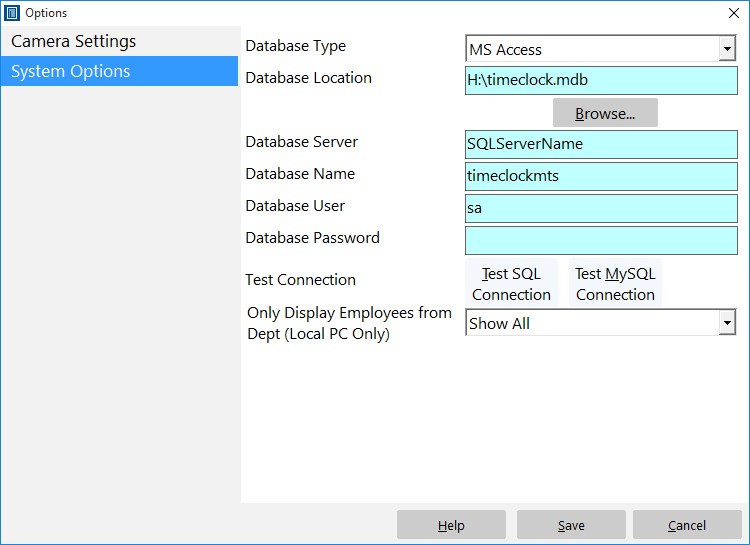
The Time Clock MTS Client System Options Screen
Once you’re on that screen click the Browse button and you’ll be shown a Windows Explorer window like the one below. It will be opened by default to the old directory that your time clock data file was in. In this example that’s the F:\Old_server folder.
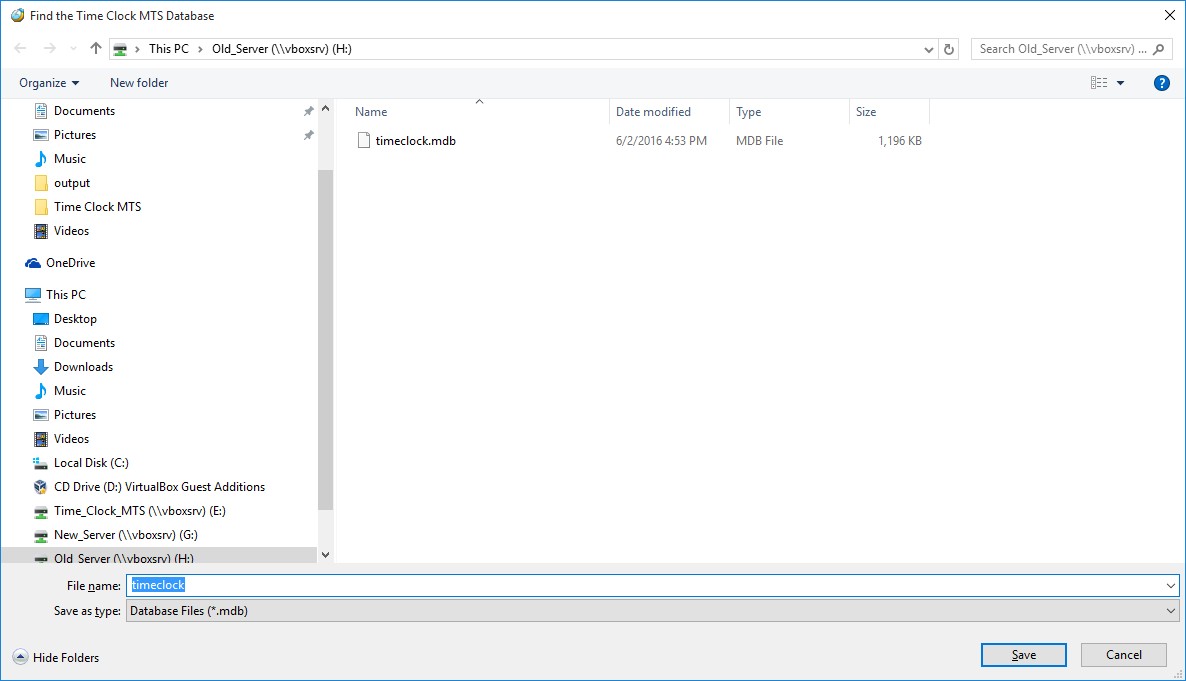
Changing the Client Data File Location 1
Now navigate to the new folder where your data file was moved to. In the case of our example that was the G:\New_Server folder.
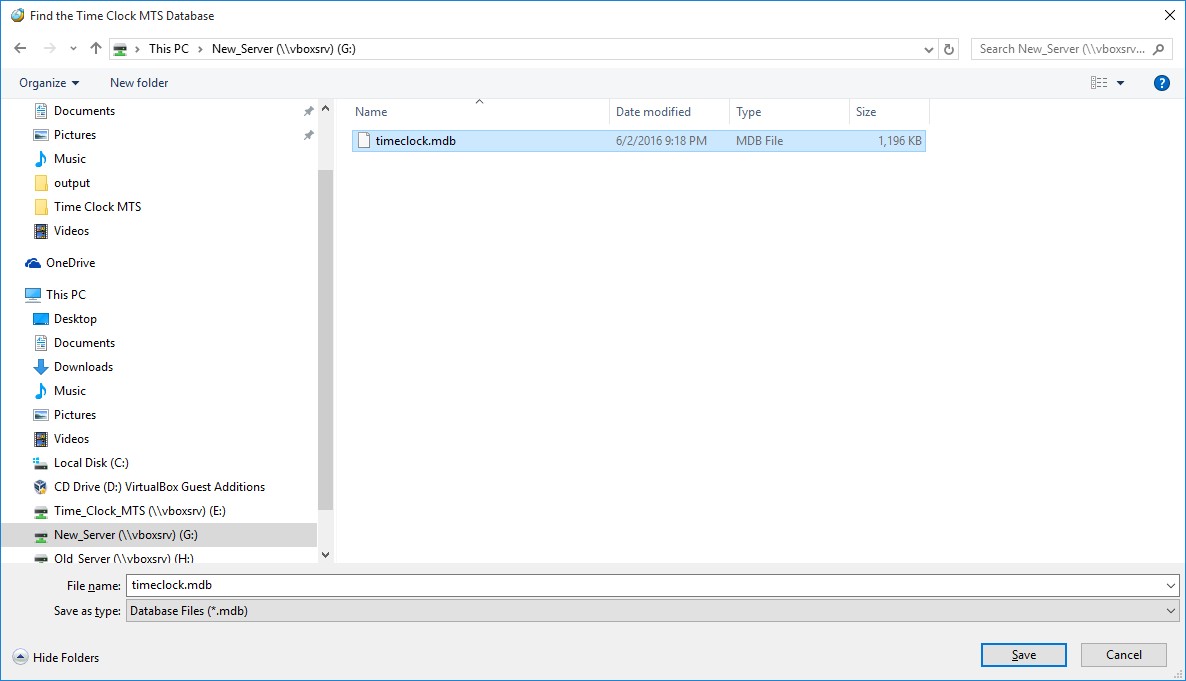
Changing the Client Data File Location 2
Click the Save button and you’ll be shown the message below informing you of your success! Don’t forget that you’ll have to follow this process for every computer that has the Time Clock MTS Client software installed on it.
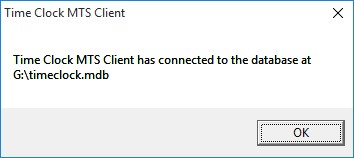
by Mark Nemtsas | Apr 30, 2015 | How To, Using the Software
SmoothPay is software for simple and efficient payroll processing. It originates from New Zealand and appears to be targeted at users in that country as well as those in Australia and Pacific nations such as PNG, Samoa, and the Solomon Islands. It runs on PC and Mac and the publishers have asked us about getting data from Time Clock MTS to their payroll system. Their export requirements are well documented and it’s a fairly simple matter to create a Time Clock MTS Export Format to suit SmoothPay.
First Step – Match Employee Badge Numbers
The first step you’re going to have to take is to match the Time Clock MTS Employee Badge Numbers with those used in SmoothPay. The badge numbers can be edited on the Employee Information Screen.
Create the Export Format
New Export Formats can be created on the Reporting->Data Export->Export Formats screen (view help topic for this screen). Navigate to that screen and create a new export format. You’ll then be shown the Add Export Format screen (see below).
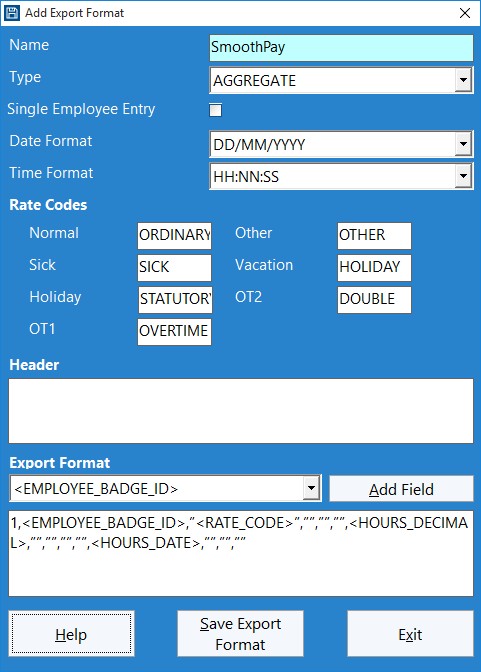
SmoothPay Data Export Format
Give the export format a name and then set the type. SmoothPay needs an aggregate format (total hours per employee for each day of the period) and requires the DD/MM/YYYY date format so you should go ahead and choose those options. Once you’ve done that you’ll need to match up your rate codes with the time types that are defined by SmoothPay. In the image above we’ve used the default SmoothPay rate codes that are found in their documentation but you should check with your own SmoothPay installation to make sure they match correctly.
The SmoothPay export file doesn’t require a header so you can leave that field blank. The final step to take is to create the actual export line format. Here’s what SmoothPay needs:
1,<EMPLOYEE_BADGE_ID>,”<RATE_CODE>”,””,””,””,<HOURS_DECIMAL>,””,””,””,””,<HOURS_DATE>,””,””,””
Just copy and paste that line into the export format text box, click the Save Export Format button and you’re done.
To use your new export format to export time clock data to SmoothPay use the Reporting->Data Export->Export Data screen.
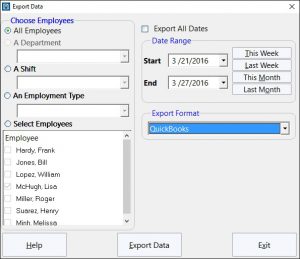
The Export Data Screen
by Mark Nemtsas | Apr 30, 2015 | How To
This Time Clock MTS How-To Guide helps users determine why their employees are not being paid overtime by the software when they believe they should be.
Check Overtime Limits
Go to the Tools->Options->Overtime Settings screen (see below) and check that overtime limits are actually set up and the overtime check boxes are ticked to tell Time Clock MTS to calculate overtime.
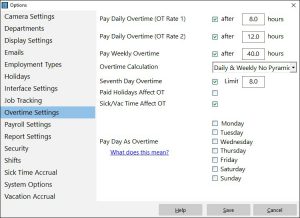
The Overtime Settings Screen
Check the Employee Payment Type
Time Clock MTS does not calculate overtime for salaried employees. Go to each employee’s Payroll Information screen (see below) and check that their payment type is set to Hourly Rate.
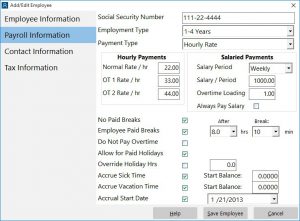
The Payroll Information Screen
Check that Employees can Accrue Overtime
It’s possible to switch off overtime accrual on an employee by employee basis. This is done via the Do Not Pay Overtime checkbox on each employee’s Payroll Information screen.
Are Employees Working Enough Hours?
The next step is to run your payroll reports and check that employees are actually working enough daily or weekly hours to exceed your overtime limits. A great report for this is the Time Breakdown Report.
Are Times Excluded from Overtime Calculations?
Administrators using the Edit Time Punch screen (see below) to edit employee’s times can adjust overtime calculations on a time by time basis. One of the settings available from the Overtime drop down box on this screen is Exclude from Overtime. If this is set then that time punch will not be included in overtime calculations. If your employees are not getting overtime paid then this may well be the reason why.
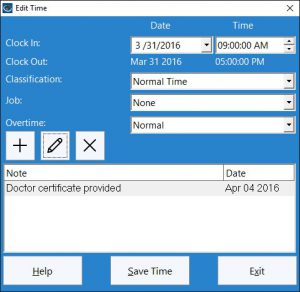
This screen is used to edit an existing time punch.
Help – I’ve Tried Everything and Overtime Still Won’t Work!
If you’ve tried everything above then please reach out to us via our contact page and we’ll help you out.
by Mark Nemtsas | Apr 25, 2015 | How To
Uninstalling Time Clock MTS couldn’t be any easier. Just follow these easy instructions:
First step is to open the Windows Control panel, which you can see below. Select the Programs – Uninstall a program option.
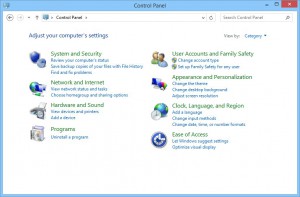
Open the Windows Control Panel
You’ll then be shown the screen below. Choose the Uninstall a program option.
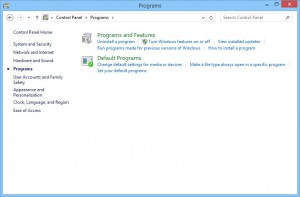
Choose the uninstall program option
Find Time Clock MTS in the installed program list that is shown to you (see below) and double click on it.
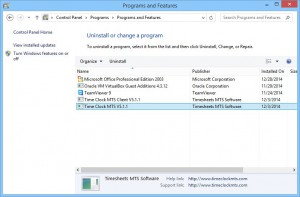
Select Time Clock MTS from the program list
Confirm that you want to uninstall Time Clock MTS.
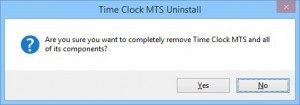
Confirm the uninstall
Let the process run and when done you’ll be shown the message below indicating the software was successfully removed from your computer.
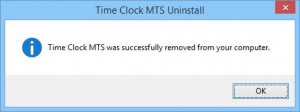
Uninstall complete!























